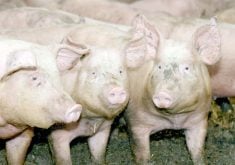CALGARY – An American researcher says it’s time to set aside breed preferences and start selecting cattle on the basis of type.
There is no magic bullet breed that will produce the right kind of beef animal every time, said Bill Mies of Texas A & M University. He spoke at the Western Stock Growers Association convention here.
“The right kind is the kind that makes you money every year because they fit every phase of the industry,” he said.
All breeders should take a serious look at what they’re producing and how the purebred animals perform commercially. Genetic data is necessary to trace which families within a breed meet these specifications.
Read Also

The Western Producer Livestock Report – October 2, 2025
Western Producer Livestock Report for October 2, 2025. See U.S. & Canadian hog prices, Canadian bison & lamb market data and sale insight.
“There’s going to be some sire lines that just don’t work,” he said.
“Specification beef” will become the buzzword in the next decade as producers move away from basic cattle production to selecting animals that yield lean and tender beef every time.
Packers set requirements
Soon packers will insist on certain criteria and they’ll penalize those who don’t comply.
Mies said packers want a carcass that weighs between 600 and 850 pounds with five millimetres of back fat and a ribeye that is about the size of an oval saucer, and as deep.
It should carry slight or better marbling and have a Warner Bratzler shear force measure of 1.6 to 4.5 kilograms. This is the amount of force necessary to cut through a piece of meat. If the measurement is below 1.6 kg of pressure, the meat is mushy, said Mies.
Feedlots will ask for cattle that can reach a slaughter weight of 1,150 pounds, grade high and remain healthy during their lifetime. Sick calves fail to gain as well and can cost an additional $50 per head before they reach slaughter.
Feedlots also want docile cattle. Wild cattle are often responsible for producing dark meat, triggered by a chemical change in the muscle tissue when the animal is stressed. Their meat is dry and tough.
Dark cutters are found in two to five percent of American carcasses at a cost to the industry of $140 a head, said Mies.
The search is also on for cattle genetically capable of depositing marbling.
“The decision on how well they marble begins the day the bull is turned out in the pasture.”

















